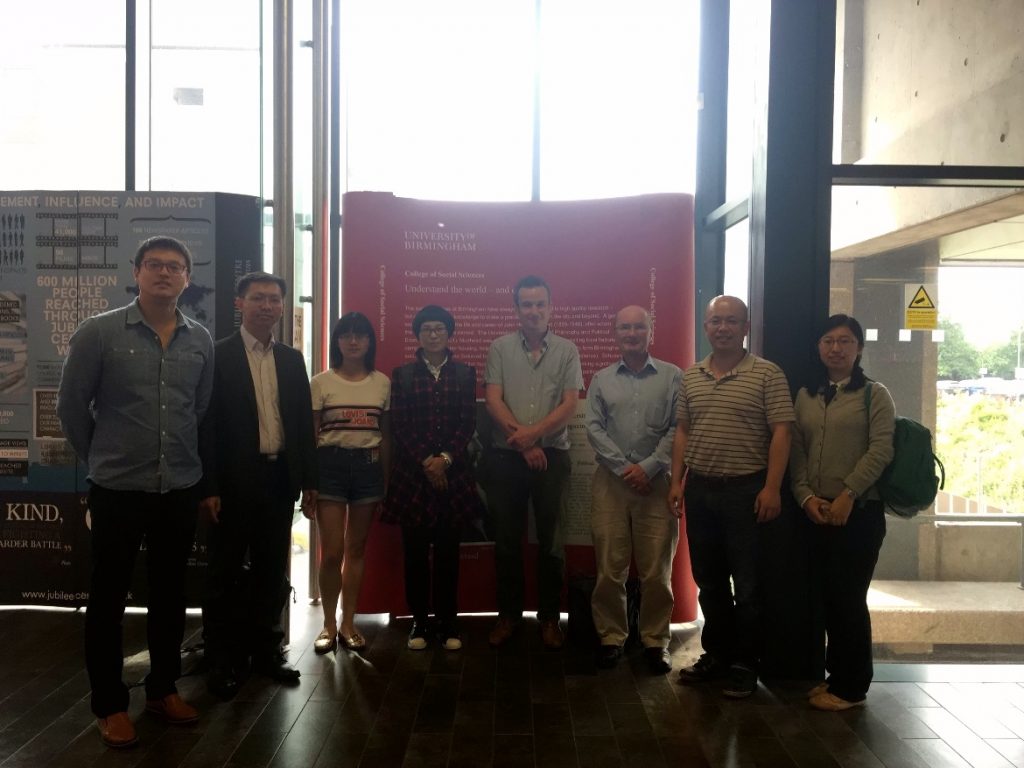Following last week’s post ‘City-REDI meets Guangzhou University’, Professor Di Cai shares her thoughts on Guangzhou University’s week with City-REDI.
 Five academics from Guangzhou University (GZU) China visited City-REDI, 19-21 June 2017. After meeting with Simon, John and other City-REDI members, new consensus has been reached that further research on the environment and smart urban development are important for both the GZU-UoB Joint Research Centre for Service Industry and Urban Development (GB-JRCSIUD), Guangzhou, and City-REDI, University of Birmingham. GZU-UoB began developing a collaborative relationship in 2012 and GB-JRCSIUD was founded in 2014. Two research projects have been successfully completed, one funded by GMG (Guangzhou Municipal Government) and the other by the Department of Education of Guangdong Province. On-going activity will continue to consolidate the impact of the GB-JRCSIUD.
Five academics from Guangzhou University (GZU) China visited City-REDI, 19-21 June 2017. After meeting with Simon, John and other City-REDI members, new consensus has been reached that further research on the environment and smart urban development are important for both the GZU-UoB Joint Research Centre for Service Industry and Urban Development (GB-JRCSIUD), Guangzhou, and City-REDI, University of Birmingham. GZU-UoB began developing a collaborative relationship in 2012 and GB-JRCSIUD was founded in 2014. Two research projects have been successfully completed, one funded by GMG (Guangzhou Municipal Government) and the other by the Department of Education of Guangdong Province. On-going activity will continue to consolidate the impact of the GB-JRCSIUD.
The Chinese Team members were all academics from the School of Geographical Sciences of GZU. They focus on different but related research area with a spatial perspective. A workshop was organized on 21th June to explore on-going research at the Joint Centre and at City-REDI.
Dr. Xiaoyue Chen’s research focuses on remote sensing and geographic information techniques for the analysis on urban land use and land cover changes, especially in the area of urban fringes and urban villages. His recent work is about the impact factors by resolution and scale of remotely sensed images to the analysis of urban expansion. He explored his on-going study on urban expansion types using multiple sources of remotely sensed images with different resolutions. The scale issue which basically comes from the resolution of the images has not been observed relevant to the monitoring and judgement of the urban expansion types. However, the time period in relation to monitoring seems to be an important factor in exploring urban expansion and in identifying types of urban expansion.
Dr. Di Cai’s research focuses on geographic information techniques to diagnose urban environmental health problem at a community scale, and the development of spatial modelling tools for smart community management with health concerns. He explored an on-going study on the relocation of office spaces from the inner city to the suburbs of Guangzhou in recent years.
Dr. Xian Shi has been working as a Post-doctoral Fellow and then as a Research Fellow at City University of Hong Kong before joining Guangzhou University in 2016. Shi’s research interests mainly focus on urban and regional governance. She has been working on research topics including urban competitiveness and intercity cooperation, revitalization of industrial buildings and mobility and social segregation. In the workshop, Shi reported on her ongoing research collaborated with Prof. Yip Ngi-ming about the revitalisation of industrial buildings in East Kowloon, Hong Kong. Adopting East Kowloon as a case study and using urban gentrification wave theory, her presentation presents three diverse kinds of gentrification that have different driving forces in the revitalisation of industrial buildings. Moreover, an institutional fix with emerging art elements was identified and examined by tracing the changes in master plan and policy reports of “Energizing Kowloon East”, a recent urban regeneration project promoted by the Government since 2011. A mixed wave of gentrification is explored in the study area, and based on the experience of Hong Kong, the concept of “compressed gentrification” is further discussed.
Dr. Chong Xu’s research interests mainly focus on urban crime and spatial analysis. He has been working on research topics including a crime risk map and crime prediction, the analysis of the influence of spatial factors on street robbery and police prevention strategy. He shared his recent research about “Spatial Heterogeneity of Micro-spatial Factors’ effects on Street Robberies”. This study examines the spatial heterogeneity in the effects of micro-spatial factors on street robberies using Moran’s I、ordinary least squared regression (OLS) model and a geographically weighted regression (GWR) model. The results shed new light on the spatial factors affecting crime rate in local scale and suggest the pitfalls of global averaging model. The proposed method in this study has the potential to help the local police department to more explicitly identify micro-spatial factors areas with high crime density and thus improve the effectiveness of crime control and prevention efforts centered on street robberies.
Professor Jianzhou Gong’s research interests focus on the Assessment of Urban Ecology, Land Use/Cover Change, Remote Sensing Retrieving. Within these areas she has published over 50 research papers and two books on urban land and ecosystem services. Her recent research includes a major focus on urban land-use allocation using a Dyna-CLUE model with a focus on Ecosystem services (Ess). Come of her current research explores ecosystem services evaluation using field-based survey data, RS and i-Tree tools.
Professor John Bryson shared the idea of Urban Living Birmingham and Integrating Urban Systems to Provide Better Outcomes for People on the workshop.
A roundtable discussion on opportunities to work together on new research areas was carried out at the end of the workshop to identify future collaborations.
To sign up to our blog mailing list, please click here
